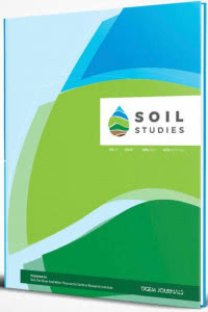Farklı Sulama Suyu Kalitesi ve Yıkama Oranı Uygulamalarında Profil Tuzluluğunun Değişimi
Bu çalışmada lizimetre koşullarında farklı sulama suyu tuzluluğu ve yıkama oranı uygulamaları altında toprak profilindeki tuzluluğun değişimi incelenmiştir. Denemeler 3 sulama suyu tuzluluğu (250, 1500 ve 3000 µS/m) ve 4 yıkama oranı (%10, 20, 35 ve 50) uygulaması ile 3 tekrarlamalı olmak üzere toplam 36 lizimetrede, tesadüf parsellerinde faktöriyel deneme biçiminde yürütülmüştür. Toprak örnekleri 0-20, 20-40, 40-60, 60-80 ve 80-100 cm derinliklerden aylık periyot ile alınmış, toprak tuzlukları 1:2.5 toprak- su ekstraktında incelenmiştir. Toprak profil tuzlulukları incelendiğinde, ortalama profil tuzluluklarının sulama suyu tuzluluklarına bağlı olarak daha az değişim gösterdiği, buna karşın yıkama hacmindeki artışlara bağlı olarak belirgin seviyede etkilendiği görülmüştür. Ortalama toprak profil tuzlulukları yıkama hacmindeki artışlara bağlı olarak azalmıştır. Aynı zamanda bütün lizimetrelerde, derinlik artışı ile tuzluluk değerlerinin de arttığı görülmektedir. Tuzluluk bileşenlerinden Cl-, Na+, Ca+2+Mg+2 içerikleri analiz edilmiş ve klor iyonunun diğer iyonlara oranla profilden daha kolay yıkanabildiği, özellikle Na+ iyonunun ise profilde değişiminin daha sınırlı düzeyde kaldığı gözlenmiştir.
Anahtar Kelimeler:
Sulama suyu tuzluluğu, toprak tuzluluğu, yıkama, Irrigation water salinity, soil salinity, leaching
Soil Salinity Changes Due to Different Irrigation Water Salinity and Leaching Fractions
In this study, soil profile salinity variations were investigated with different irrigation water salinity and leaching fractions in lyzimeters, under the open-rain conditions. Experiments were carried out with three irrigation water salinity levels (0.25, 1.5 ve 3.0 dS/m) and four leaching fractions (%10, 20, 35 ve 50) with three replications, totally in 36 lyzimeters, with fully randomized factorial design. Soil samples were taken out from 0-20, 20-40, 40-60, 60-80 ve 80-100 cm soil depths in monthly basis. Soil salinity were measured in 1:2,5 soil water ratio. Average soil salinities in the profile were not affected significantly from the irrigation water salinity level, but leaching fraction effected the soil salinities. Soil salinity decreased with increasing leaching fraction, and also increased with depth for all treatments. Soil salinities of each layer increased with the increasing salinity level of irrigation water throughout the irrigation period. Variations of some salinity components in the soil profiles which are Cl-, Na+, and Ca+2+Mg+2 were also analyzed. It was faund that Cl- was highly soluble and leached easily from the profiles. In contrary Ca+2, Mg+2 and especially Na+ were not easliy leached and accumulated in the profile even in lyzimeters applied more leaching water.
___
Anonymous, (1954). Diagnosis and Improvement of Saline and Alkali Soils. U.S. Dept. of Agric. No: 60, USA. Ayers, R.S. and Westcot, D.W. (1989). Water quality for agriculture. FAO Irr. and Drain Paper No:29, p.1- 174, Rome.Corwin, D.L. and Lesch, S.M. (2005a). Apparent soil electrical conductivity measurements in agriculture. Computers and Electronics in Agriculture, 46:11-43.
Corwin, D.L. and Lesch, S.M. (2005b). Characterizing soil spatial variability with apparent soil electrical con- ductivity, I. Survey protocols. Computers and Electronics in Agriculture, 46:103-133.
Corwin, D.L. and Lesch, S.M. (2005c). Characterizing soil spatial variability with apparent soil electrical con- ductivity, II. Case study. Computers and Electronics in Agriculture, 46:135-152.
Oster, J.D. and Rhoades, J.D. (1978). Calculated drainage water compositions and salit burdens resul- ting from irrigation with river waters in the Western United States. J. of Environmental Quality, 4:73-79.
Suarez, D.L. and Rhoades, J.D. (1977). Effect of leaching fraction on river salinity. J. of Irrig. And Drain. Div., 103(IR2):245-257.
Van Hoorn, J.W. and van Alpen, J.G. (1988). "Salinity Control, Salt Balance and Leaching Requirement of Irrigated Soils," ICAMAS Istituto Agronomico Mediterraneo di Bari, Italy.
Yurtseven, E. ve Sönmez, B. (1996). Sulama suyu tuzluluğunun domates verimine ve toprak tuzluluğuna etkisi. Tr.J. of Agriculture and Forestry, 20(1):27-33.
Yurtseven, E. Güngör, Y. (1990). Değişik tuzluluk düzeylerindeki sulama sularının toprak tuzlulaşması- na etkisi. Tr.J. of Agriculture and Forestry, 14:555- 561.
Yurtseven, E., Öztürk, A., Çaycı, G. and Parlak, M. (2000). Effects of leaching with irrigation waters in dif- ferent salinity levels on change of profile salinity. Proceedings of International Symposium of Desertification (ISD) 13-17 June 2000, Konya/Turkey, ISBN 975-19-2485-5, pp.397-402.
Yurtseven, E., Çaycı, G., Sevimay, C.S., Öztürk, A., Parlak, M. (2002). Tuzluluk ve su miktarlarının macar fiği (Vicia pannonica, Crantz) verimi ve toprak tuzlulu- ğuna etkisi: II.Değişik tuzluluktaki sularla yıkama yapılması koşulu. A.Ü. Ziraat Fak. Tarım Bilimleri Dergisi, 8(2):101-108.
Yurtseven, E., Öztürk, H.S., Ünlükara, A., and Kesmez, G.D. (2002). Effects of Irrigation Water Quality on Leaching and Salinity in Soil Profiles. OECD Workshop on Innovative Soil-Plant Systems For Sustainable Agricultural Practices (Poster), 3-7 june 2002, İzmir/Türkiye. Workshop on ISPS- SAP(WISPS) Programme and Abstracts pp.50.
Yurtseven, E., Öztürk, H.S., Ünlükara A., Kesmez, G.D. (2001). Sulama suyu tuzluluğunun toprak tuzlu- laşmasına ve yıkanmaya etkisi. 1. Ulusal Sulama Kongresi Bildiriler Kitabı, 8-11 Kasım 2001, Antalya/Belek, s. 333-338.
- ISSN: 2146-7072
- Yayın Aralığı: Yılda 2 Sayı
- Yayıncı: Toprak Gübre ve Su Kaynakları Merkez Araştırma Enstitüsü
Sayıdaki Diğer Makaleler
Hatice DAĞHAN, N. KÖLELİ, V. UYGUR, M. ARSLAN, D. ÖNDER, V. GÖKSUN, N. AĞCA
Bitki Beslemede Sürdürülebilir Yönetim Stratejisi ve Gübre Etkinlik Parametreleri
Mehmet Rüştü KARAMAN, Metin TURAN
Kadriye KALINBACAK, İlknur YURDAKUL, İbrahim GEDİKOĞLU
İklimsel Değişikliklerin Pamuk Üretimine Etkilerinin İncelenmesi
Farklı Sulama Suyu Kalitesi ve Yıkama Oranı Uygulamalarında Profil Tuzluluğunun Değişimi
Engin YURTSEVEN, Hasan S. ÖZTÜRK, Sertan AVCI, Suzan ALTINOK, M.fatih SELENAY
